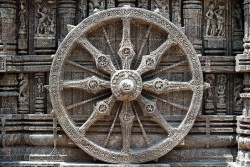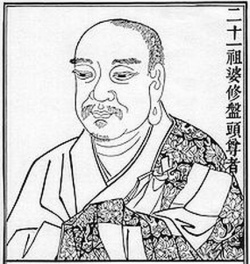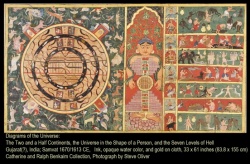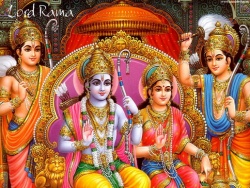Vasubandhu: Viṃśatikā-kārikā-vṛtti
This is the fourth installment in a series of posts chronicling my encounter with Vasubandhu, the philosopher who, with his half-brother Asaṅga, founded the Yogācāra school of Buddhism. I remain just about completely clueless about the subject, so, as usual, don't believe a word of what I'm saying. For the other episodes, see here.
Vasubandhu's Viṃśatikā-kārikā, or "Twenty Verses (on Representation-Only)" is one of his two best-known works. It is, I hear, also one of his most commonly misunderstood ones. Perhaps this was already the case in his own lifetime, because he also wrote a commentary on it. Be as it may, I found the Twenty Verses much more approachable than the Discussions on the five aggregates and action.
The Twenty Verses and their autocommentary are among the last things Vasubandhu wrote. He has dropped the meticulous, dialectical Abhidharmika approach in favor of an almost poetic, impressionistic, free-form style. He no longer seems all that interested in providing impeccable logical proofs of every statement; instead, he takes a metaphysical claim as a starting point, and then explores its ethical and metaphysical implications through the lens of his own experience. It would be pretty easy to pick apart his argumentation in some points, but having fought my way through his earlier work, I have no doubt at all that he could have produced much tighter (and more difficult to read) demonstrations, had he found it necessary. I'm kinda glad he didn't, because it makes the text much easier to read—although, no doubt, even easier to misunderstand.
It's also worth noting that the Twenty Verses have been preserved in the original Sanskrit, unlike the Discussions and Vāda-vidhi. Perhaps the process of translation, deconstruction, reconstruction, and retranslation has made them even harder to read than they would have been otherwise.
An Excursion into the Abhidharma
As I've been reading Vasubandhu and writing these notes on my encounters with him, I've grown increasingly frustrated at my cluelessness about the conceptual framework he's using—the Abhidharma. Since I don't want to get completely sidetracked from this little project, I took an extremely quick crash course. Meaning, I poked around the Internet and ended up reading two essays about it.
From them, I gathered that the Abhidharma is a massive, systematic catalogue of phenomena of consciousness—those cittas Vasubandhu goes on about—and their relationships, arranged into a multidimensional matrix. Together, it constitutes a total model of cognition. It can't easily be expressed in any other format. You can't write it up as an essay, for example, because regular text is one-dimensional.1 You can write lots of things about it, though, and that's what Abhidharmikas have done. In terms of scope, the Abhidharma looks about as big as, say, physics, which means that I am to an Abhidharmika roughly what your average third-grader is to Walter H.G. Lewin, and there I'm probably flattering myself.
The Abhidharma is primarily a phenomenology, not a metaphysical philosophy. That means that it's about the world as we perceive it, rather than about the world "as it really is," whatever that may mean. Nevertheless, it does include a set of metaphysical claims, and apparently a good many of the doctrinal disputes between the various Buddhist schools in Vasubandhu's time involved precisely the metaphysical aspect of the Abhidharma. The Sārvāstivādins, for example, believed in the ontological existence of a past and a future, something Vasubandhu refuted in his Discussion for the Demonstration of Action.
In the Abhidharmic model, the cognitive process consists of clusters of cittas. Each cluster goes through a similar progression. It starts with a dhamma entering a sense-field, which creates contact. Contact gives rise to a sensory impression. This is followed by examination, which causes a perception to arise. The perception then causes a discrimination. This is either an aversion, a desire, or indifferent. The discrimination is followed by a decision, which is followed by an action, which leaves a karmic impression, which will eventually mature into a retributive effect.2
Metaphysics are relevant when discussing the point of contact between the observer and the observed; the subject and the object—a dhamma entering a sense-field.3 According to the Abhidharmikas, a dhamma is a constituent part of the universe, sort of like an atom in that it is both indivisible and considered "real"—having independent, objective, ontological existence—but not much like what we think of as atoms, because they're only defined in relation to the senses. As Bhikkhu Bodhi and U Rewata Dhamma explain it:
Briefly, the dhamma theory maintains that ultimate reality consists of a multiplicity of elementary constituents called dhammas. The dhammas are not noumena hidden behind phenomena, not "things in themselves" as opposed to "mere appearances," but the fundamental components of actuality. The dhammas fall into two broad classes: the unconditioned dhamma, which is solely Nibbana, and the conditioned dhammas, which are the momentary mental and material phenomena that constitute the process of experience. The familiar world of substantial objects and enduring persons is, according to the dhamma theory, a conceptual construct fashioned by the mind out of the raw data provided by the dhammas. The entities of our everyday frame of reference possess merely a consensual reality derivative upon the foundational stratum of the dhammas. It is the dhammas alone that possess ultimate reality: determinate existence "from their own side" (sarupato) independent of the mind's conceptual processing of the data.
—Bhikkhu Bodhi and U Rewata Dhamma in Introduction to the Abhidhammattha Sangaha
So that's where Vasubandhu's insistence on atoms in the Discussions comes from. It's also where he departs from Abhidharmika orthodoxy in the Twenty Verses, with some pretty radical results.
The World as Representation-Only
The central metaphysical conceit in the Twenty Verses is that the dhammas aren't really real. Or, rather, that their existence is only inferrable: since we only become aware of them once the cognitive process enters the conscious stage, by which time contact and the sensory impression has already occurred, we cannot experience dhammas directly, any more than the root-consciousness. We can only make inferences based on our perceptions, which are based on our sense-impressions (and seed-cittas maturing in the root-consciousness.)
Vasubandhu points out that perceptions are not necessarily based on any objective reality. Dreams, for example, seem entirely real to the dreamer, but they are not shared. In normal life, we're constantly negotiating some kind of consensual reality, based on different citta-streams agreeing that they're perceiving similar things, and agreeing to give these similar things shared labels. A lucid dream—I hear intensive meditation can make them more frequent—is just as "real" to the dreamer as what we call "everyday reality." Vasubandhu also points out that dreaming is clearly not separate from the material world, either, since an oversexed young monk having a certain kind of dream will often ejaculate into his pyjamas, or whatever it was they slept in back then. Even Abhidharmikas would admit that those perceptions are not caused by really-existing dhammas.
A sense-object is neither a single thing,
nor several things,
from the atomic point of view,
nor can it be an aggregate
so atoms can't be demonstrated.
Vasubandhu argues that there is no fundamental difference between cognition in a dream-state, and in what we call a waking-state. In other words, he's pointing out that atomic cittas and dhammas are mental constructs, just like everything else. There may well be an objective Universe out there, but all we ever see of it is a representation—at least if we're using the ordinary, phenomenological mind. Sounds an awful lot like what the French post-structuralists I hate keep going on about.
Vasubandhu goes on to explore the implications of this shift in the metaphysical framework. This exploration leads him into some pretty interesting territory. Specifically, he explores states of consciousness that we would call abnormal—dreams and "hell-states"—those worlds into which hungry ghosts are born due to karmic retribution.
Hell-states, he says, are exactly like dreams—states where the existence of an external sense-object can't be demonstrated.
For all the pretas who are in a similar situation due to a similar retribution for an action … see a river filled with pus. With the expression "etc." rivers full of urine and feces, guarded by men holding clubs or swords, and other such perceptions, are included also. Thus, non-restriction as to moment-series in regard to perceptions is demonstrated even with an external object of sense or understanding being non-existent.
He then goes on to present a logical argument against the objective existence of these pus-rivers, as well as "hell-guardians, dogs, and crows." The argument is mostly an ethical one, and it would be pretty easy to pick holes in it—but then I got the feeling that he could easily have provided tighter and more coherent ones, had someone asked. He is effectively writing the supernatural out from Buddhism.
What Happens to Personal Responsibility?
There is an obvious ethical objection to Vasubandhu's idea that there is no fundamental difference between waking and dreaming; that things—dhammas, sense-objects, whatever—only exist as representations. Namely: if everything only exists in the mind, what difference does it make what you do?
So how can the dying of sheep who have been attacked by shepherds take place? If their dying takes place without the shepherds having done anything, how can the shepherds be held responsible for the offense of taking of life?
Here's where Vasubandhu's answer made me go ? After just debunking supernaturalism, he invokes a sutra describing how some forest-dwelling renunciants used their magical mental powers to screw with a nasty asura, and then points out that since direct mental action can cause harm, you don't need to invoke physical activity like gutting a sheep. From where I'm at, that's a very transparent dodge. Either I'm missing something really obvious, or Vasubandhu is just messing with our heads. I think the reason might be that in order to answer this question we'd have to define what, exactly, the 'shepherd' and the 'sheep' are, which brings us right back to the question whether there is a 'self' or not, and what that implies. Perhaps Vasubandhu just doesn't want to go there. Either way, he leaves that question unanswered.
Personally, I think there is an answer to that objection. Ethically relevant action happens in the realm of the phenomenal world; the world of perception-only. An ethically meaningful act involves an actor, an object being acted upon, and an intention. An actor can only act on an object if both 'actor' and 'object' exist as representations in the 'actor's' consciousness. The ontological existence, or lack thereof, of the 'actor' and 'object' are irrelevant to the ethical equation; all that matters is that the 'actor' thinks of the 'object' as existing, and has an intention about the action. Since Vasubandhu has shown in the Discussion for the Demonstration of Action that he is a pure intentionalist, the distinction between physical and mental activity is already irrelevant, never mind the sutras; what matters is the intention behind the action.
In fact, Vasubandhu implies something like this answer elsewhere in the Twenty Verses, where he explains why actions carried out in dreams do not carry ethical baggage. This is not because the objects of those actions have no ontological existence, but because the dreamer's mind is affected by torpor, i.e., because the dreamer is not fully aware and in control of his actions. By extension, I would assume that Vasubandhu would be very sympathetic to pleas of not guilty by reason of insanity—and, perhaps, that acts carried out by a lucid dreamer would have karmic consequences.
Samsara is Nirvana
Nevertheless, the Twenty Verses is not only or even primarily a metaphysical or ethical treatise; it is a mystical work, with its primary aim to be yet another of those famous fingers pointing at the moon. He concludes his work by pointing to its very own nature as representation-only. Representation-only is transcendence, something that cannot be fully apprehended by reasoning, but only by contemplation and the mystical insight that follows. The whole point of the exercise is to go beyond this world of representation-only, to recognize the emptiness of representations, and ultimately "become awakened by the attainment of supermundane knowledge free from discriminations…[to] truly understand the non-being of these sense-objects through meeting with a clear worldly subsequently attained knowledge."
Once again, we come to the heart of the matter: the awakening from the world of forms into the world beyond concepts.
Here, O Sariputra,
all dharmas are marked with emptiness ;
they are not produced or stopped, not defiled or immaculate, not deficient or complete.
Therefore, O Sariputra,
in emptiness there is no form nor feeling, nor perception, nor impulse, nor consciousness ;
No eye, ear, nose, tongue, body, mind ; No forms, sounds, smells, tastes, touchables or objects of mind ; No sight-organ element, and so forth, until we come to :
No mind-consciousness element ; There is no ignorance, no extinction of ignorance, and so forth, until we come to : There is no decay and death, no extinction of decay and death. There is no suffering, no origination, no stopping, no path.
There is no cognition, no attainment and no non-attainment.
The Heart Sutra
The next work in the collection I'm reading is Triṃśikā-kārikā, The Thirty Verses. This continues where the Twenty Verses left off, exploring the way the structure of the mind relates to the idea of perception-only, and what it means with regards to meditational attainments and the Eightfold Path.




